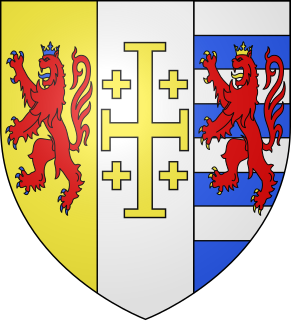
James I was regent of the Kingdom of Cyprus for his infant nephew King Peter II from 1369. When Peter died in 1382, James became King of Cyprus. James was also titular King of Armenian Cilicia and Jerusalem 1382–1398.

Leo V or Levon V, of the House of Lusignan, was the last Latin king of the Armenian Kingdom of Cilicia. He ruled from 1374 to 1375.

Leo IV or Leon IV was the last Hethumid king of Cilicia, ruling from 1320 until his death. He was the son of Oshin of Armenia and Isabel of Korikos, and came to the throne on the death of his father. His name is sometimes spelled as Leo or Leon.

Leo I, also Levon I or Leon I, was the fifth lord of Armenian Cilicia or “Lord of the Mountains” (1129/1130-1137).
Toros II the Great, also Thoros II, was the sixth lord of Armenian Cilicia or “Lord of the Mountains” (1144/1145–1169).
Mleh I, also Meleh I, was the eighth lord of Armenian Cilicia or “Lord of the Mountains” (1170–1175).
Constantine II, also Kostandin II, was the fourth lord of Armenian Cilicia or “Lord of the Mountains” (1129/1130).

Leo II, also Leon II, Levon II or Lewon II, was the tenth lord of Armenian Cilicia or “Lord of the Mountains” (1187–1198/1199), and the first king of Armenian Cilicia (1198/1199–1219). During his reign, Leo succeeded in establishing Cilician Armenia as a powerful and a unified Christian state with a pre-eminence in political affairs. Leo eagerly led his kingdom alongside the armies of the Third Crusade and provided the crusaders with provisions, guides, pack animals and all manner of aid. Under his rule, Armenian power in Cilicia was at its apogee: his kingdom extended from Isauria to the Amanus Mountains.
Ruben III, also Roupen III, Rupen III, or Reuben III, was the ninth lord of Armenian Cilicia or “Lord of the Mountains” (1175–1187).
Ruben II, also Roupen II or Rupen II, (c.1165–1170) was the seventh lord of Armenian Cilicia or “Lord of the Mountains” (1169–1170).
Bohemond IV of Antioch, also known as Bohemond the One-Eyed, was Count of Tripoli from 1187 to 1233, and Prince of Antioch from 1201 to 1216 and from 1219 to 1233. He was the younger son of Bohemond III of Antioch. The dying Raymond III of Tripoli offered his county to Bohemond's elder brother, Raymond, but their father sent Bohemond to Tripoli in late 1187. Saladin, the Ayyubid sultan of Egypt and Syria, conquered the county, save for the capital and two fortresses, in summer 1188.

Henry II was the last crowned King of Jerusalem and also ruled as King of Cyprus. He was a Lusignan dynast.

Isabella I, also Isabel I or Zabel I, was the queen regnant of Cilician Armenia (1219–1252).
Constantine I or Kostandin I was the second lord of Armenian Cilicia or “Lord of the Mountains”. During his rule, he controlled the greater part of the regions around the Taurus Mountains, and invested much of his efforts in cultivating the lands and rebuilding the towns within his domain. He provided ample provisions to the Crusaders, for example during the difficult period of the siege of Antioch in the winter of 1097. He was a passionate adherent of the separated Armenian Church.
Amalric, Lord of Tyre, also called Amalric of Lusignan or Amaury de Lusignan was a prince and statesman of the House of Lusignan, a younger son of King Hugh III of Cyprus and Isabella of the House of Ibelin. He was given the title of Lord of Tyre in 1291, shortly before the city of Tyre fell to the Mamluks of Egypt. He is often but incorrectly called the Prince of Tyre.

The Ramnulfids, or the House of Poitiers, were a French dynasty ruling the County of Poitou and Duchy of Aquitaine in the 9th through 12th centuries. Their power base shifted from Toulouse to Poitou. In the early 10th century, they contested the dominance of northern Aquitaine and the ducal title to the whole with the House of Auvergne. In 1032, they inherited the Duchy of Gascony, thus uniting it with Aquitaine. By the end of the 11th century they were the dominant power in the southwestern third of France. The founder of the family was Ramnulf I, who became count in 835.
Constantine of Baberon was a powerful Armenian noble of the Het‛umid family. He was the son of Vassag and the father of King Het‛um I, who ruled the Armenian Kingdom of Cilicia from 1226 to 1270. Constantine played a pivotal role in placing his son on the throne by engineering the murder of Philip, the husband of Isabella, Queen of Armenia. He tricked Philip’s father, Bohemond IV of Antioch, to search for his son at Amouda rather than at Sis, where he was being tortured and poisoned. He then took his army to the gates of Silifke Castle, forced its Frankish lords to surrender Isabella, and arranged the marriage, making his son the first Het‛umid ruler of the Armenian Kingdom.

The War of the Antiochene Succession, also known as the Antiochene War of Succession, comprised a series of armed conflicts in northern Syria between 1201 and 1219, connected to the disputed succession of Bohemond III of Antioch. The Principality of Antioch was the leading Christian power in the region during the last decades of the 12th century, but Armenian Cilicia challenged its supremacy. The capture of an important fortress, Bagras, in Syria by Leo II of Cilicia gave rise to a prolonged conflict already in the early 1190s. Leo tried to capture Antioch, but the Greek and Latin burghers formed a commune and prevented the Armenian soldiers from occupying the town. Bohemond III's eldest son, Raymond, died in 1197, leaving an infant son, Raymond-Roupen. The boy's mother, Alice of Armenia, was Leo I's niece and heir presumptive. Bohemond III and the Antiochene noblemen confirmed Raymond-Roupen's right to succeed his grandfather in Antioch, but the commune preferred Bohemond III's younger son, Bohemond, Count of Tripoli.










